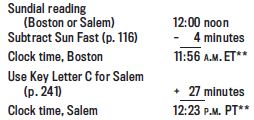To convert the time to your (nearest) city, use Key Letter C on page 238.
EXAMPLE:
To change sundial to clock time in Boston or Salem, Oregon, on day 1:

**Note: Add 1 hour to the results in locations where Daylight Saving Time is currently observed.
4. This column gives the degrees and minutes of the Sun from the celestial equator at noon ET.
5. This column gives the approximate times of high tide in Boston. For example, the first high tide occurs at 7:15 a.m. and the second occurs at 8:00 p.m. the same day. (A dash indicates that high tide occurs on or after midnight and is recorded on the next day.) Figures for calculating approximate high tide times for localities other than Boston are given in the Tide Corrections table on page 236.
6. To calculate the moonrise time in your locale: Choose a day. Note the Moon Rise Key Letter. Find your (nearest) city on page 238. Add or subtract the minutes that correspond to the Moon Rise Key Letter to/from the moonrise time given for Boston.
LONGITUDE OF CITY |
CORRECTION MINUTES |
LONGITUDE OF CITY |
CORRECTION MINUTES |
|---|---|---|---|
| 58°–76° | 0 | 116°–127° | +4 |
| 77°–89° | +1 | 128°–141° | +5 |
| 90°–102° | +2 | 142°–155° | +6 |
| 103°–115° | +3 |
(A dash indicates that the moonrise occurs on/after midnight and is recorded on the next day.) Find the longitude of your (nearest) city on page 238. Add a correction in minutes for your city's longitude (see table, bottom left). Use the same procedure with Boston's moonset time and the Moon Set Key Letter value to calculate the time of moonset in your locale.
EXAMPLE:
To calculate the time of moonset in Lansing, Michigan, on day 1:

7. This column gives the Moon's astronomical position among the constellations (not zodiac) at midnight. For astrological data, see pages 224–227. Constellations have irregular borders; on successive nights, the midnight Moon may enter one, cross into another, and then move to a new area of the previous. It visits the 12 zodiacal constellations, as well as Auriga (AUR), a northern constellation between Perseus and Gemini; Cetus (CET), which lies south of the zodiac, just south of Pisces and Aries; Ophiuchus (OPH), primarily north of the zodiac but with a small corner between Scorpius and Sagittarius; Orion (ORI), whose northern limit first reaches the zodiac between Taurus and Gemini; and Sextans (SEX), which lies south of the zodiac except for a corner that just touches it near Leo.
8. This column gives the Moon's age: the number of days since the previous new Moon. (The average length of the lunar month is 29.53 days.) (continued)